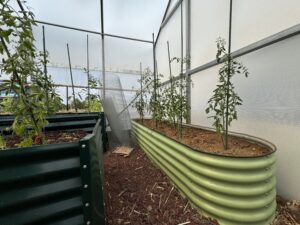Harnessing Thermal Mass in High Tunnel Greenhouses for Sustainable Year-Round Growing

In the world of high tunnel greenhouses, creating the ideal growing environment often comes down to one key factor: temperature control. Especially for growers seeking year-round production, maintaining a stable, consistent temperature inside the greenhouse is essential. One often-overlooked solution to achieve this balance is thermal mass.
At Steady Harvest, we believe understanding and using thermal mass in your high tunnel greenhouse can make all the difference in both plant health and energy efficiency. Let’s dive into what thermal mass is, how it works, and why it’s crucial for your high tunnel greenhouse.
What is Thermal Mass?
Thermal mass refers to any material that absorbs, stores, and releases heat. In the context of a high tunnel greenhouse, materials such as water, stone, concrete, or even soil can act as thermal masses. These materials absorb heat during the day when the greenhouse warms up, then slowly release that stored heat during the cooler night hours. This process helps to regulate temperature fluctuations, creating a more consistent growing environment.
Why is Thermal Mass Important for Greenhouse Growing?
1. Temperature Stabilization
One of the biggest challenges in greenhouse growing is managing the rapid temperature swings that occur between day and night. High tunnel greenhouses, in particular, can heat up quickly during the day due to their light-permeable coverings and cool off just as fast once the sun goes down. By integrating thermal mass into your greenhouse design, you help to mitigate these extremes, ensuring a more stable temperature range for your plants. This stability fosters healthier growth and protects your crops from potential damage due to frost or overheating.
2. Energy Efficiency
For growers aiming to extend their growing season into colder months, traditional heating methods like propane or electric heaters can become expensive. By using thermal mass, you can reduce your reliance on these energy sources. A well-implemented thermal mass system will absorb enough heat during the day to keep the greenhouse warm at night, reducing the need for supplemental heating and ultimately lowering your energy costs.
3. Plant Health
Fluctuations in temperature can stress plants, leading to slower growth or reduced yields. The steady warmth provided by thermal mass helps to create an environment where plants can thrive, even during colder months. For heat-sensitive crops, thermal mass can also help to prevent overheating, as it absorbs excess heat during the hottest part of the day. This results in better overall plant health, leading to more consistent yields.
4. Sustainability
Using thermal mass is a sustainable, eco-friendly approach to temperature management in your high tunnel greenhouse. By harnessing the natural heat of the sun and reducing the need for artificial heating and cooling, you’re not only cutting down on your carbon footprint but also aligning with the principles of sustainable agriculture. This makes thermal mass an essential tool for growers committed to environmentally responsible practices.
How to Incorporate Thermal Mass in Your High Tunnel Greenhouse
Now that we understand the benefits of thermal mass, how do we incorporate it into a high tunnel greenhouse? Here are some practical strategies:
– Water Barrels: Placing large barrels of water along the interior walls of your greenhouse is one of the most effective ways to implement thermal mass. Water has a high heat capacity, meaning it can absorb and retain large amounts of heat. Painted black, these barrels will absorb even more heat during the day and release it slowly at night.
– Stone or Concrete Flooring: If you’re building a new greenhouse or making modifications, consider using stone, concrete, or even brick for the flooring. These materials not only absorb and release heat but also help to anchor the structure, providing additional benefits in terms of durability.
– Thermal Mass Walls: Adding a wall of rocks or bricks at the back of your greenhouse can create a passive heat bank. This is particularly effective if the wall is positioned to receive maximum sunlight during the day.
– Raised Beds with Soil Mass: Soil itself can act as thermal mass. Raised garden beds filled with soil or other dense materials will naturally absorb heat during the day, which helps to keep root zones warmer at night.
Final Thoughts
At Steady Harvest, we believe that growing smarter means harnessing the power of natural processes to create optimal growing environments. Integrating thermal mass into your high tunnel greenhouse is a simple yet powerful way to stabilize temperatures, reduce energy consumption, and improve plant health. Whether you’re growing for personal use or commercial production, thermal mass can play a crucial role in achieving consistent, sustainable harvests all year long.
Interested in learning more about how you can maximize the potential of your greenhouse? Stay tuned to Steady Harvest for more tips, or contact us for expert advice on building your perfect high tunnel system!




